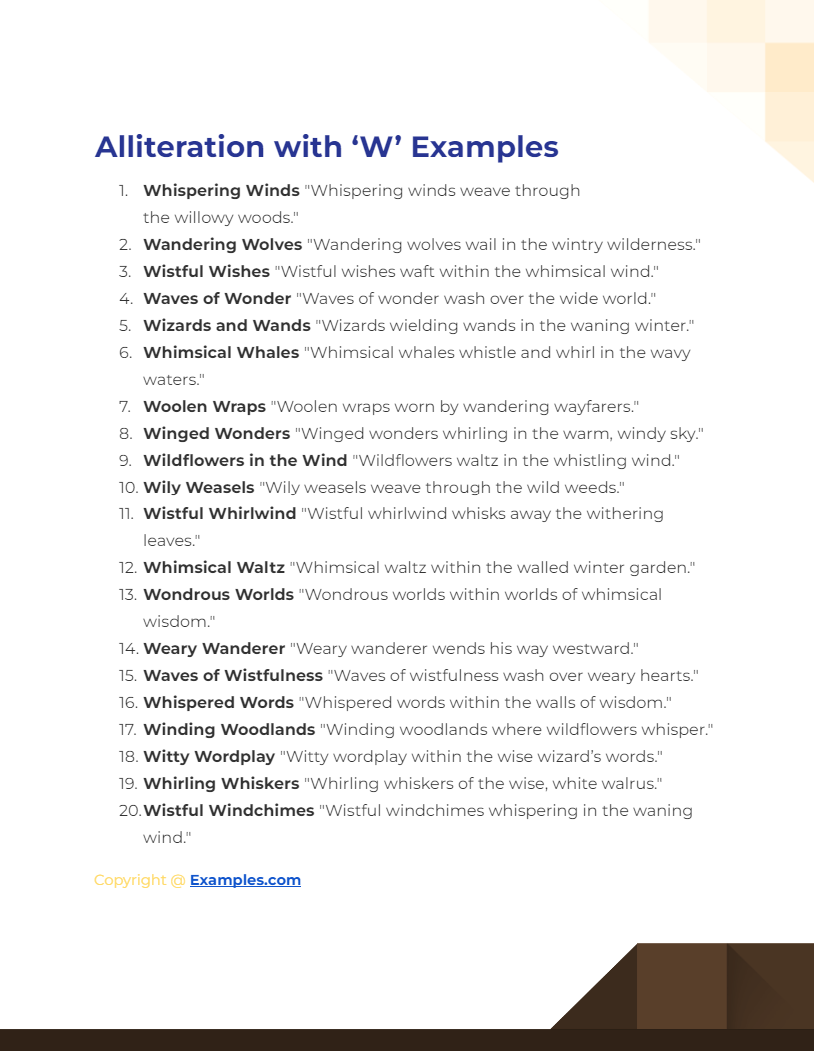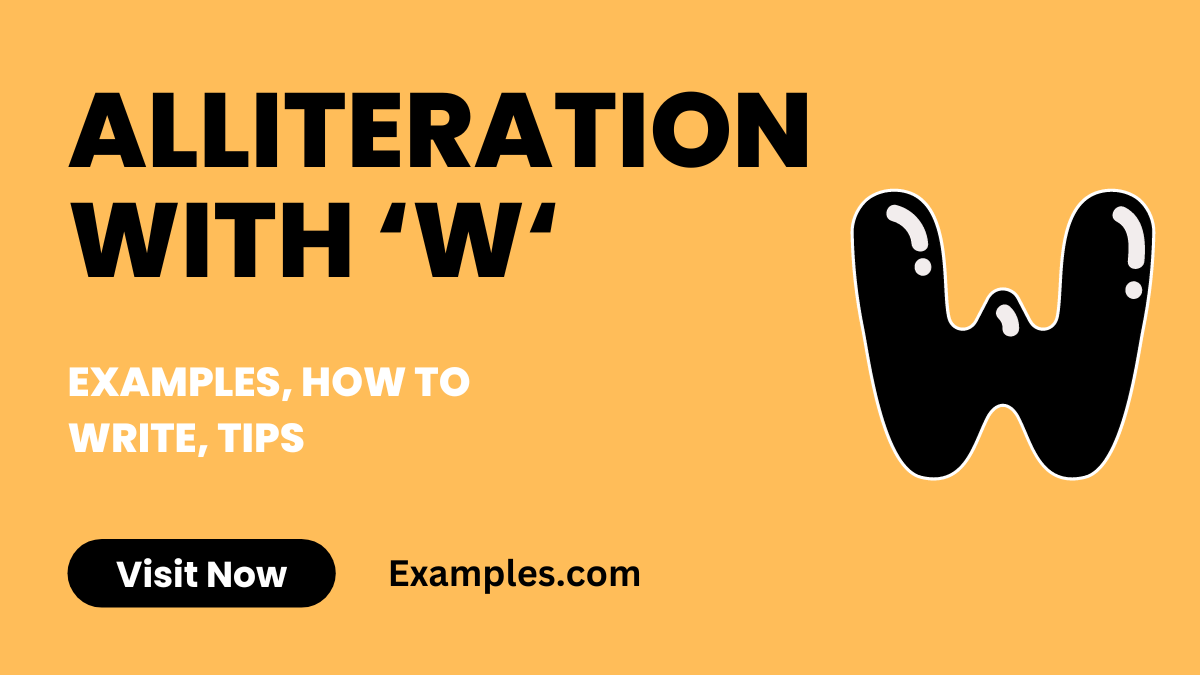19+ Alliteration with W Examples
Welcome to the wonderful world of Alliteration with ‘W’! Alliteration is a poetic and linguistic technique that involves using the same consonant sound at the beginning of several words in close succession. In this article, we will explore the art of famous alliteration specifically with the letter ‘W.’ You’ll find a collection of creative examples, learn how to craft your own alliterations with ‘W,’ and discover some valuable tips to make your writing more whimsical and wondrous. So, let’s embark on this wordplay journey with ‘W’!
Download Alliteration with 'W' Examples
Download Alliteration with 'A' to 'Z' Examples
What is the Best Example of Alliteration with ‘W’?

Example: A classic example of alliteration with the letter ‘W’ is the phrase “Wild and windy weather whistled through the willow trees.”
Meaning: Alliteration is a literary device that involves the repetition of the same consonant sound at the beginning of words in close proximity. In the example “Wild and windy weather whistled through the willow trees,” the consonant ‘W’ is repeated in multiple words, creating a rhythmic and melodious effect. This technique is often used in poetry, literature, and speeches to enhance the sound and flow of the text. In this specific example, the easy alliteration repeated ‘W’ sound emphasizes the description of the weather and adds a sense of movement and atmosphere to the sentence.
20 Alliteration with ‘W’ Examples

Download Alliteration with 'W' Examples in PDF
Alliteration with the letter ‘W’ creates a whimsical whirl of wondrous and witty words, weaving a tapestry of textural and often whimsical auditory experiences. The ‘W’ sound, known for its warmth and sometimes whimsical quality, is ideal for crafting hard alliteration examples. Especially effective in alliteration in rhymes, the ‘W’ sound adds a rhythmic and engaging dimension to verses. Here are 20 unique examples of alliteration with ‘W’, each complemented by a rhyme title that captures the essence of the phrase.
- Whispering Winds “Whispering winds weave through the willowy woods.”
- Wandering Wolves “Wandering wolves wail in the wintry wilderness.”
- Wistful Wishes “Wistful wishes waft within the whimsical wind.”
- Waves of Wonder “Waves of wonder wash over the wide world.”
- Wizards and Wands “Wizards wielding wands in the waning winter.”
- Whimsical Whales “Whimsical whales whistle and whirl in the wavy waters.”
- Woolen Wraps “Woolen wraps worn by wandering wayfarers.”
- Winged Wonders “Winged wonders whirling in the warm, windy sky.”
- Wildflowers in the Wind “Wildflowers waltz in the whistling wind.”
- Wily Weasels “Wily weasels weave through the wild weeds.”
- Wistful Whirlwind “Wistful whirlwind whisks away the withering leaves.”
- Whimsical Waltz “Whimsical waltz within the walled winter garden.”
- Wondrous Worlds “Wondrous worlds within worlds of whimsical wisdom.”
- Weary Wanderer “Weary wanderer wends his way westward.”
- Waves of Wistfulness “Waves of wistfulness wash over weary hearts.”
- Whispered Words “Whispered words within the walls of wisdom.”
- Winding Woodlands “Winding woodlands where wildflowers whisper.”
- Witty Wordplay “Witty wordplay within the wise wizard’s words.”
- Whirling Whiskers “Whirling whiskers of the wise, white walrus.”
- Wistful Windchimes “Wistful windchimes whispering in the waning wind.”
Alliteration Sentence Examples with ‘W’
Alliteration sentence examples with ‘W’ often weave a whimsical or wistful tone, utilizing the ‘W’ sound to add a warm and sometimes whimsical rhythm to the text. This type of alliteration is popular in various literary forms, including alliteration in poems, songs, and movies, where it contributes to the narrative’s charm. Here are three examples:
- “Wendy’s white wisteria wound whimsically around the window.”
- “Walter’s wobbly wagon wove wildly through the wheat fields.”
- “The wise old willow whispered secrets to the wandering wind.”
Alliteration Examples with ‘W’ Words
Alliteration examples using ‘W’ words demonstrate the potency of this consonant in creating vivid, memorable phrases. Often employed in alliteration in songs, the ‘W’ sound adds a lively, engaging element. Here are three examples:
- “Waves of warmth washed over the weary wanderers.”
- “Whirling whirlpools whirl wickedly within the watery depths.”
- “Willful whispers wove through the wistful winter night.”
Alliteration Examples with ‘W’ Name
Incorporating names that start with ‘W’ in alliteration adds a personal and often endearing touch to phrases, making them more engaging and vivid. Here are three examples:
- “Wendell’s wise words wove a web of wisdom.”
- “Wilma’s waltzing was widely admired at the weekend gala.”
- “Winston’s whimsical ways won him many warm-hearted friends.”
Alliteration Examples with ‘W’ Sound
The ‘W’ sound in alliteration can create effects ranging from soft and whispery to bold and resonant. These examples show diverse applications of the ‘W’ sound in alliterative structures. Here are three examples:
- “Whispering willows waved at the wandering wildlife.”
- “The watchful wolf waited warily in the waning light.”
- “Waves washed over the worn wooden wharf.”
Alliteration Poems with ‘W’
An alliteration poem with ‘W’ employs the repetitive ‘W’ sound to create a rhythmically and aesthetically engaging poetic experience. Alliteration in poems, especially with the ‘W’ sound, brings a unique lyrical quality. Here are three examples:
- “Winds whispering softly, / Winding through the willowy trees.”
- “Winter’s white blanket wraps, / While the world quietly naps.”
- “Wildflowers waving in the breeze, / Wondrous sights that easily please.”
Alliteration Starting with ‘W’
Alliteration beginning with ‘W’ sets a specific tone and rhythm in a phrase, often creating a memorable and impactful auditory experience. Found in various artistic expressions, including alliteration in movies, it adds a distinctive flair. Here are three examples:
- “Willa’s whimsical words won over the wary audience.”
- “The weary warrior watched the waning moon.”
- “Waves of wonder washed over Will as he watched the stars.”
How to Write Alliteration with ‘W’?
Creating alliteration with the letter ‘W’ involves strategically placing words that start with the ‘W’ sound close together within your sentences or phrases. The ‘W’ sound, known for its warmth and sometimes whimsical quality, can add a unique rhythm and tone to your writing. This technique is versatile, used across various contexts, from educational materials like alliteration for first grade to more complex alliteration in figurative language compositions. Here’s how to craft effective alliteration with ‘W’:
- Understand the ‘W’ Sound: Familiarize yourself with the ‘W’ sound. It’s a consonant that can bring energy and a certain whimsical quality to your writing.
- Select a Theme or Concept: Choose a theme or subject. This helps in finding relevant ‘W’ words that fit your topic, whether you’re crafting alliteration with answers or for creative expression.
- Brainstorm ‘W’ Words: Make a list of words beginning with ‘W’. Include a variety of words (nouns, verbs, adjectives) to add richness to your alliteration.
- Construct Your Phrase or Sentence: Arrange the ‘W’ words to form a coherent and rhythmic sentence. Aim for a natural flow that highlights the alliterative effect.
- Read Aloud for Rhythm: The effectiveness of alliteration is often best judged audibly. Read your sentence aloud to ensure it flows well and the ‘W’ sound is pronounced clearly.
- Revise for Clarity and Impact: Ensure your alliterative phrase is clear and contributes effectively to your overall message or story.
- Apply in Various Contexts: Whether it’s in alliteration figurative language exercises, as part of teaching alliteration for first grade, or in creative writing, adapt your use of ‘W’ alliteration to suit the purpose and audience.
Tips for Using Alliteration with ‘W’
- Use Sparingly: While alliteration can enhance your writing, overusing it can make your text feel overdone. Use it to emphasize key points or add stylistic flair in moderation.
- Maintain Clarity: Your primary goal is to convey a message clearly. Alliteration should complement, not complicate, your narrative.
- Vary Word Length and Complexity: Mix short and long ‘W’ words, as well as simple and complex words, for a more dynamic textual rhythm. This is particularly important in alliteration for first grade, where simpler language is essential.
- Consider the Mood: The ‘W’ sound can be warm and inviting or whimsical and playful. Use it in contexts where this mood is appropriate.
- Read and Revise: Reading your work aloud helps you assess the rhythm and flow. Adjust as needed to ensure the alliteration enhances the text.
- Appropriate for Audience: Tailor your alliteration to your audience. For example, alliteration for first grade should be simpler and more playful than alliteration for adults.
- Explore Different Forms: Try ‘W’ alliteration in various forms of writing, from poetry and stories to advertising and academic work, to understand its effect.
Remember, the key to effective alliteration with ‘W’ is balancing its unique sound with readability, ensuring that the alliterative phrases enhance your writing.
What are the Alliteration with ‘W’ for Students?
Alliteration with ‘W’ for students is a linguistic tool that enhances their grasp of language, phonetics, and literary devices. Utilizing words that start with the ‘W’ sound in close sequence, it helps in developing vocabulary and creative expression. For students, ‘W’ alliterations can range from simple phrases for younger learners to more complex constructs for older students. Examples include:
- “Wendy’s white whale watches the wavy water.”
- “William’s wooden wagon wobbled on the winding path.”
- “Walter whispered wise words about the wilderness.”
These examples aid in teaching alliteration for students, enhancing their language skills in a fun and engaging way.
What are the Alliteration with ‘W’ for Kids?
Alliteration with ‘W’ for kids involves creating simple, engaging, and often playful phrases that utilize the ‘W’ sound. This form of alliteration is excellent for early language development, helping children learn phonetics in an enjoyable manner. Examples designed for alliteration for kids include:
- “Willy the worm wiggled on the wet watermelon.”
- “Wendy’s wildflowers were wonderfully colorful.”
- “The wacky wizard waved his wand in the windy weather.”
These examples are crafted to be easy for children to remember and recite, making learning fun.
What is the Effect of ‘W’ Letter in Alliteration?
The effect of the ‘W’ letter in alliteration is to create a warm, sometimes whimsical sound that adds a rhythmic and engaging quality to language. The ‘W’ sound, being a voiced labio-velar approximant, has a soft yet pronounced quality, making it effective for drawing attention to specific phrases and enhancing the rhythmic quality of the text. In alliterative literature, ‘W’ alliteration is often used to set a particular mood or to add a dynamic quality to the narrative. Its versatility makes it significant in both alliteration for kids and more sophisticated works for adults. The ‘W’ sound is also important in alliteration and assonance, contributing to the overall sonic appeal of a piece.
What is the Alliteration ‘W’ Type of?
Alliteration with the letter ‘W’ is a type of consonantal alliteration, where the consonant sound at the beginning of adjacent or closely connected words is repeated. This form of alliteration is common and effective in various forms of writing, from creative poetry to prose. The ‘W’ type of alliteration can create different effects, from warm and inviting to whimsical and playful, depending on the context and the words chosen. This form of alliteration is seen in a wide range of literary contexts, from educational materials like alliteration for students to more complex literary compositions for adults. It is often used in conjunction with alliteration and assonance exercises to explore the sonic qualities of language. The ‘W’ type of alliteration is appreciated for its ability to add a rhythmic and engaging quality to writing, enhancing its impact and memorability.


